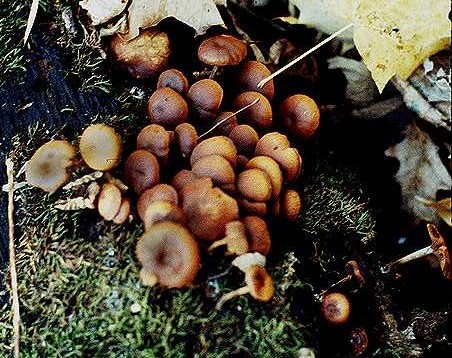Habitat and Adaptations
Galerina autumnalis is commonly, but not always, found in mossy habitats which is typically in a warm, moist environment. This is a type of environment that can be found on almost every continent except for Antarctica.

Typically, a cluster of these fungi are found on, or close to,
rotten or decaying wood for a dependable food source. As mentioned in the nutrition
page, this fungi is known as being a decomposer. Without
decomposers, the environment would be cluttered with dead material.
The ideal habitat needed for G. autumnalis to thrive
consists primarily of dead wood. This diet can be found in more diverse places than
simply decomposing the forest floor.
Tom Volk
 To the right is an example of the environment in which G.
autumnalis can be found.
To the right is an example of the environment in which G.
autumnalis can be found.
As tempting as it may seem, remember that this is a mushroom that
should not be consumed! Moss does not have to be present, but it is
usually commonly associated with the fruiting body.
Tom Volk
In this picture G. autumnalis is letting themselves into a home by deciding to grow in the dead wood of a doorway.
Tom Volk
Environmental Adaptations
Since fungi are sessile organisms, it is not able to move in order
to acquire its nutrients or change location. Then how do these
little mushrooms keep appearing everywhere? With the combination of hyphae and wind pollinating spores
the organism is spread across the environment and feeding on dead
wood. Take a look at the
nutrition and
reproduction pages
for more detailed information.

The image of Galerina autumnalis to the right shows the structure known as the cap, which houses the gills that contain the spores needed in reproduction. There is also the stem-like section that is called the stipe which can be almost translucent in color when wet.
Braaten 2013.
Back to nutrition Go home Continue to interactions
